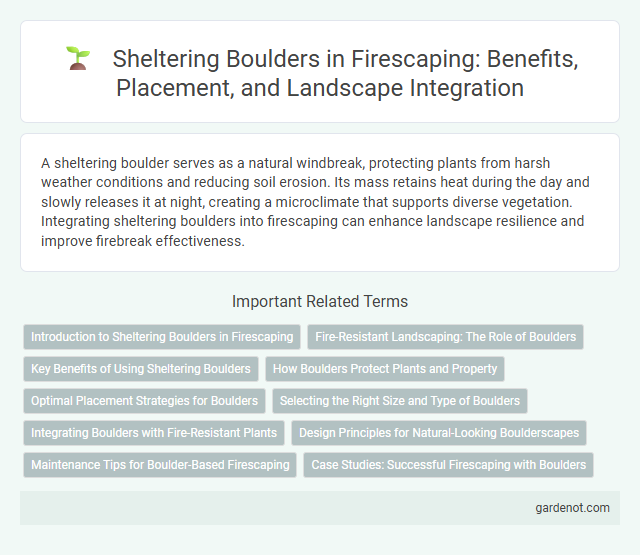A sheltering boulder serves as a natural windbreak, protecting plants from harsh weather conditions and reducing soil erosion. Its mass retains heat during the day and slowly releases it at night, creating a microclimate that supports diverse vegetation. Integrating sheltering boulders into firescaping can enhance landscape resilience and improve firebreak effectiveness.
Introduction to Sheltering Boulders in Firescaping
Sheltering boulders play a crucial role in firescaping by acting as natural firebreaks that slow down the spread of wildfires. These large rocks absorb and radiate heat, reducing the intensity of flames and protecting nearby vegetation. Strategically placing sheltering boulders in landscape design enhances fire resistance by creating defensible spaces and promoting safer evacuation routes.
Fire-Resistant Landscaping: The Role of Boulders
Sheltering boulders serve as natural firebreaks in fire-resistant landscaping by blocking and redirecting radiant heat away from vulnerable vegetation and structures. Their high thermal mass absorbs heat during wildfires, reducing the likelihood of fire spread and protecting nearby plants from ignition. Strategically placed boulders can enhance defensible space, contributing to safer property landscapes in wildfire-prone areas.
Key Benefits of Using Sheltering Boulders
Sheltering boulders provide natural fire barriers that significantly reduce wildfire spread by blocking wind-driven flames and embers. Their mass absorbs and dissipates heat, protecting nearby vegetation and structures from intense radiant heat. Integrating sheltering boulders into firescaping designs enhances landscape resilience and reduces the need for extensive fuel removal.
How Boulders Protect Plants and Property
Sheltering boulders act as natural firebreaks by absorbing and deflecting heat, reducing the risk of fire damage to nearby plants and structures. Their large mass and non-combustible nature slow fire spread, creating safer microclimates for vegetation growth and protecting property from intense heat and flames. Strategically placed boulders can also shield soil from erosion and retain moisture, promoting healthier plant life in fire-prone landscapes.
Optimal Placement Strategies for Boulders
Optimal placement strategies for sheltering boulders in firescaping involve positioning large, fire-resistant rocks to create natural firebreaks that slow wildfire spread. Placing boulders near structures, along property perimeters, and within defensible spaces enhances protection by disrupting fuel continuity and reducing radiant heat exposure. Strategic boulder placement also promotes safe zones for firefighters and helps preserve vegetation by directing fire away from sensitive areas.
Selecting the Right Size and Type of Boulders
Choosing the right size and type of sheltering boulders is crucial for effective firescaping, as larger, dense granite or basalt boulders provide superior heat resistance and create natural firebreaks. Optimal boulder placement requires considering proximity to structures and vegetation, ensuring gaps are minimized to prevent ember infiltration and enhance protection. Selecting irregularly shaped boulders with sufficient mass helps dissipate heat, reducing fire intensity near vulnerable areas.
Integrating Boulders with Fire-Resistant Plants
Sheltering boulders provide natural firebreaks by embedding fire-resistant plants like succulents, lavender, and rosemary around their bases, reducing fuel load and slowing wildfire spread. Strategic placement of boulders amidst drought-tolerant, low-flammability vegetation enhances landscape resilience and creates microclimates that support moisture retention. This integration minimizes ignition risk and promotes long-term fire safety in firescaping design.
Design Principles for Natural-Looking Boulderscapes
Sheltering boulders in firescaping should mimic natural formations by incorporating irregular shapes, varied sizes, and earth-toned colors to blend seamlessly with the environment. Strategic placement near plants and water features enhances fire resistance while maintaining an organic aesthetic. Integrating sheltering boulders with fire-resistant vegetation creates a balanced, functional landscape that reduces wildfire risk and preserves natural beauty.
Maintenance Tips for Boulder-Based Firescaping
Sheltering boulders in firescaping require regular inspection to ensure stability and prevent shifting that could compromise fire safety. Removing debris, such as dry leaves and twigs, from crevices in the boulders reduces fuel for potential fires and enhances fire resistance. Applying a fire-resistant sealant periodically helps protect the boulders from heat damage and supports long-term durability in fire-prone environments.
Case Studies: Successful Firescaping with Boulders
Sheltering boulders have proven effective in firescaping by acting as natural firebreaks in numerous case studies across wildfire-prone regions like California and Australia. These large rocks reduce flame intensity and slow fire spread, protecting homes and vegetation by creating defensible spaces without extensive landscaping changes. Incorporating boulders into fire-adapted landscapes demonstrates a cost-effective, sustainable method for enhancing wildfire resilience while preserving natural aesthetics.
Sheltering boulder Infographic

 gardenot.com
gardenot.com